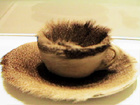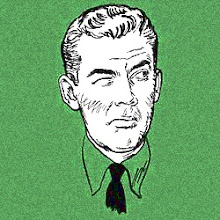 At right, Paul Claudel playing solitaire.
At right, Paul Claudel playing solitaire.I’ve written here before about the
state of surrealism in 1960, and now I want to return to the matter and have a longer look at Wallace Fowlie, arguably the most important explainer and promoter of French surrealism in the U.S. at the time.
Fowlie taught modern French literature at Bennington, Chicago, and Yale, and in 1964 went to Duke where he stayed until the end. His last book, written when he was 85, was about Rimbaud and Jim Morrisson of The Doors:
The Poet as Rebel. In one remembrance I found on the web, a student of Fowlie’s recalls the great teacher’s “celibacy and minimalism,” remembers going to Fowlie’s apartment for a b.s. session with other students and being mesmerized by the Jim Morrisson poster on the wall which he saw while hearing Fowlie intone that he was simply a faithful Catholic. The student was astonished and delighted by what he considered a remarkable contrast or convergence. But no contrast at all: Fowlie was a devotee of surrealism, Catholicism and the literary tradition that produced such figures as Narcissus, Hamlet, and the clown.
In 1960 he published a new edition (put out by Hillary House) of his 1957 book on Paul Claudel. He also published his
Dionysus in Paris: A Guide to Contemporary French Theater (Meridian, ’60), a dual-language book published by Bantam called
French Stories/Contes Francais, the Gateway Editions edition of Claudel’s
Break of Noon and another of Claudel’s
Tidings Brought to Mary, and yet another Claudel edition brought out by Regnery (all in 1960).
In his time Fowlie was underestimated by literary academia in the U.S. David O’Connell has written that this “is the reaction that any man of staunch moral conviction who is also prolific arouses in an age of confusion and mediocrity.” Probably so. But there’s more: Fowlie avoided the huge existentialist fad that ran through modern language and English departments in the fifties and sixties, and was somewhat left out because of what seemed an Old School attitude. Actually, New School...for Fowlie’s indifference to the existentialist fad – a response to apparent desire among undergrads to read deep stuff in French lit classes – was an affirmation of surrealism as the main current from early modernism to his time.
A crucial document is Fowlie’s “Surrealism in 1960,” a commentary piece written for
Poetry Magazine. He looks back at surrealist automatic writing. It was a means, he says, by which the surrealists attempted by reach the absolute. They intended to reveal the emptiness and falsity of logical discourse, and to emancipate words from the bondage of rhetorical speech. While automatic writing might have failed – the surrealists themselves felt it didn’t do entirely what they’d wanted – Fowlie suggests that that part of the surrealist project has had a great influence on later writers. He commends the surrealists’ renunciation of “all activity of control over speech” (through which it was hoped that people would emerge as themselves).
So in this piece he looks at surrealists in his day – ’60. He sees that Jean Paulhan, Maurice Blanchot, and Raymond Queneau, in their conception of language “as a new instrument,” are essentially surrealists.
He discusses Henri Michaux and Francis Ponge in the surrealist context.
And he looks back to Jarry’s character Ubu, the “representative of surrealist humor,” and finds that Raymond Queneau “today is still expressing in a recognizably surrealist way this doctrine of humor.” Queneau is the Ubu of 1960.
It’s 1960, yes, and the year in which Donald Allen published the great
New American Poetry anthology, but separately and parallel (but not intersecting, as surrealism is not a conscious consideration in the structure of Allen’s book – except indirectly through the poems there by Ashbery and the comic-surrealist strain in some lines of the Beats). Perhaps a more important point than anything implied by the consolidation of the New Americans in Allen is something Wallace Fowlie added toward the end of “Surrealism in 1960”: “An historical study of surrealism makes it out to be anti-literary and anti-poetical.
Yet today it seems to us the founder of a new literature and a new poetry."One last thing about Fowlie before I leave him. He was born in Brookline, Mass., with no connection to France or things French (except indirectly through some forms of Catholicism). But one day, as a child, he happened to be at the Copley Plaza Hotel in Boston where the French Ambassador to the U.S. - yes, it was Paul Claudel himself - gave an utterly incomprehensible speech. The young Wallace Fowlie knew right then what he wanted to do.
 The photo at left shows Hemingway with Fidel Castro in 1960. But for now let's talk about Hem's poems. Yes, poems.
The photo at left shows Hemingway with Fidel Castro in 1960. But for now let's talk about Hem's poems. Yes, poems. The bio note in Poetry for January 1923 calls Hem "a young Chicago poet now abroad, who will soon issue his first book of poems." Edmund Wilson quipped that these "are not particularly important" but they do show the writer moving in the main poetic current of the time, at least very generally: what might be called precise yet poignant discernment.
The bio note in Poetry for January 1923 calls Hem "a young Chicago poet now abroad, who will soon issue his first book of poems." Edmund Wilson quipped that these "are not particularly important" but they do show the writer moving in the main poetic current of the time, at least very generally: what might be called precise yet poignant discernment.








































 Is '60 the moment when the end of the end of the Old Left had been reached and the New Left began to emerge? Is it the final ascendancy, in certain scenes at least, of poetic postmodernity? Surely the publication of Donald Allen's The New American Poetry that year suggests this, but then again--once again--we look back on "New" here and see continuity. The rhetoric of the Kennedy-Nixon contest made much less of a dent than everyone (at the time as well as since) claimed, so one wonders why were such great claims made?
Is '60 the moment when the end of the end of the Old Left had been reached and the New Left began to emerge? Is it the final ascendancy, in certain scenes at least, of poetic postmodernity? Surely the publication of Donald Allen's The New American Poetry that year suggests this, but then again--once again--we look back on "New" here and see continuity. The rhetoric of the Kennedy-Nixon contest made much less of a dent than everyone (at the time as well as since) claimed, so one wonders why were such great claims made?  Had we come to expect "1960" to be truly ubiquitously modern in a way that the 1950s really were not--not quite? And what specifically does "modern" mean in the Kennedyesque talk then and now about the torch being passed to a new generation, etc.? The First Lady really meant "modernist" when Camelotians said "modern." What about the others across the new young cultural leadership? I've been surprised by how frequently the
Had we come to expect "1960" to be truly ubiquitously modern in a way that the 1950s really were not--not quite? And what specifically does "modern" mean in the Kennedyesque talk then and now about the torch being passed to a new generation, etc.? The First Lady really meant "modernist" when Camelotians said "modern." What about the others across the new young cultural leadership? I've been surprised by how frequently the  "Beat movement" was covered in 1960 in the mainstream press. I was expecting a fair measure but I've found tonnage. 1960 was the year when the figure of the beat was beginning to find acceptance, although still 80% of these stories are mocking, rebels-without-cause condescension. For anyone whose analysis made an impact nationally, do these antipolitical adolescents count as part of the "new young cultural leadership"? No, but rather than the two being opposites, they fall along a Continuum of the New American. Now that's a change for '60.
"Beat movement" was covered in 1960 in the mainstream press. I was expecting a fair measure but I've found tonnage. 1960 was the year when the figure of the beat was beginning to find acceptance, although still 80% of these stories are mocking, rebels-without-cause condescension. For anyone whose analysis made an impact nationally, do these antipolitical adolescents count as part of the "new young cultural leadership"? No, but rather than the two being opposites, they fall along a Continuum of the New American. Now that's a change for '60.







